160/80m coaxial Receiving Loop
Several years ago a friend of mine (W7AE)(sk) and myself became interested in low band dxing. Lacking room for a beverage receiving antenna, we constructed several loop receiving antenna to see if we could find a suitable low /lower noise receiving antenna.
W7AE built the first loop for 160m following plans laid out in the ARRL Antenna Handbook. Encouraged by the results I built one for 80m. I found that with a proper pre-amp, such the Palomar series, or Ameco's PT-3 there was a significant lowering of noise, but the signals that I was unable to hear on my sloper now were quite workable using the receiving loop. For the past several years, we experimented with several different configurations , including a circular, and square loop. We found that the diamond configuration worked the best.The 80m version requires a pre-amp to bring the signal up to an acceptable quality. We've found that there is a one to two s unit difference (depending how high you set the gain on the preamp)in the lowering of noise. There have been several times that the loop has made the difference between working a DX station or not hearing him on my sloper.Though the antenna is not a beverage, we've found it to be a good alternative.
The stand alone 80m loop is approximately four feet in diameter. And made of light weight material. Which makes it ideal for portable use or you can mount it above a pre-existing vhf antenna. Due to it's small size it is quite rotatable , which is advantagous when you which to null out noise. The 160m version is approximately eight feet in diameter. Though twice the size of the 80m version it also is quite rotatable. The combination 160/80m loop has the same diameter as the 160 stand alone loop. Also the combination 160/80m loop is fed with a single lenth of coax. We have found that a preamp located in the shack to be more advantagious. That way you can adjust the gain and tune control for each loop. Mechanical specification are subject to change. Especially if I find a way to improve on the design. Also we have been experimenting with phasing two loops for added gain. Watch the page for details.



No comments:
Post a Comment